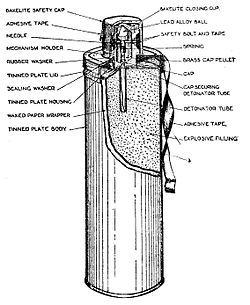- No. 73 Grenade
-
No. 73 
Hand Percussion Grenade (anti-tank No 73 Mark I)[1]Type Anti-tank grenade Place of origin  United Kingdom
United KingdomService history In service 1940-1941
1943-?1945Used by  United Kingdom
United KingdomWars Second World War Specifications Weight 4.5 pounds (2.0 kg) Length 11 inches (280 mm) Diameter 3.5 inches (89 mm) Filling Polar ammonal gelatine dynamite or nitrogelatine Filling weight 3.5 pounds (1.6 kg) Detonation
mechanismImpact The No. 73 grenade, also known as the Thermos or Woolworth bomb,[2] was a British anti-tank grenade used during the Second World War. It got its nickname from the resemblance to a Thermos flask.
Contents
Development
With the end of the Battle of France and the evacuation of the British Expeditionary Force from the port of Dunkirk between 26 May and 4 June 1940, a German invasion of Great Britain seemed likely.[3] However, the British Army was not well-equipped to defend the country in such an event; in the weeks after the Dunkirk evacuation it could only field twenty-seven divisions.[4] The Army was particularly short of anti-tank guns, 840 of which had been left behind in France and only 167 were available in Britain; ammunition was so scarce for the remaining guns that regulations forbade even a single round being used for training purposes.[4] As a result of these shortcomings, a number of new anti-tank weapons had to be developed to equip the British Army and the Home Guard with the means to repel German armoured vehicles.[5] Many of these were anti-tank hand grenades, large numbers of which could be built in a very short space of time and for a low cost.[2] They included the Grenade, Hand, Anti-tank No. 74, also known as the 'Sticky bomb', which was coated with a strong adhesive and 'stuck' to a vehicle, and the No. 76 Special Incendiary Grenade, essentially a British variation on the Molotov cocktail.[6] Ian Hogg states that the "simplest of these grenades" was the No. 73 grenade, which was known under a variety of names, including the hand percussion grenade,[7] the Thermos bomb and the Woolworth bomb.[2]
Design
The No. 73 grenade had a roughly cylindrical shape and plastic screw-on cap,[8] similar to that of a Thermos flask, from which the 'Thermos bomb' nickname was derived.[9] It was approximately 3.5 inches (89 mm) in diameter and 11 inches (280 mm) in length,[10] and weighed some 4.5 pounds (2.0 kg). Its explosive content consisted of 3.5 pounds (1.6 kg) of polar ammonal gelatine dynamite or nitrogelatine - both of which were easily flammable and could be detonated by the impact of small-arms fire.[8] When thrown at a tank or other vehicle, a weighted tape held in the users hand unravelled and pulled free a safety pin, which was attached to a No. 69 "All-ways" fuse; this armed and then subsequently detonated the grenade.[11] However, its considerable weight meant that it could only be thrown short distances,[2] limiting its range to between 10 yards (9.1 m) and 15 yards (14 m),[8] and its detonation could injure the user if they did not find cover before it detonated.[2] It was able to penetrate 2 inches (51 mm) of armour,[12] and "damage severely any light tank."[7] However, it was best used against the tracks of a tank, which it could easily blow off[8] and force its crew to waste time by stopping and repairing it.[13]
Operational history
The No. 73 grenade was first issued in the last months of 1940, but it was rarely used as an anti-tank grenade; instead the fuse was usually removed and it was used as a demolition charge. It was withdrawn from service within a year, and reissued again in 1943 for the express purpose of being used for demolition work.[8]
See also
References
- ^ Military Training Manual No 42.
- ^ a b c d e Mackenzie, p. 92
- ^ Mackenzie, p. 20
- ^ a b Lampe, p. 3
- ^ Hogg, pp. 237-239
- ^ Hogg, pp. 239-240
- ^ a b Hogg, p. 239
- ^ a b c d e Rottman, World War II Infantry Assault Tactics, p. 25
- ^ Longmate, p. 77
- ^ Rottman, World War II Infantry Assault Tactics, p. 62
- ^ Bull, p. 30
- ^ Rottman, World War II Infantry Anti-Tank Tactics, p. 62
- ^ Bull, pp. 30-31
Bibliography
- Bull, Stephen; Dennis, Peter; Delf, Brian; Chappell, Mike; Windrow, Martin (2004). World War II Infantry Tactics. Osprey Publishing. ISBN 1841766631.
- Hogg, Ian (1995). Tank Killers: Anti-Tank Warfare by Men and Machines. Pan Macmillan. ISBN 0330353160.
- Lampe, David (1968). The Last Ditch: Britain's Secret Resistance and the Nazi Invasion Plan. Greenhill Books. ISBN 9781853677304.
- Longmate, Norman (1974). The Real Dad's Army: The Story of the Home Guard. Hutchinson Library Services.
- Lowry, Bernard; Taylor, Chris, Boulanger, Vincent (2004). British Home Defences 1940-45. Osprey Publishing. ISBN 1841767670.
- Mackenzie, S.P. (1995). The Home Guard: A Military and Political History. Oxford University Press. ISBN 0198205775.
- Rottman, Gordon L.; Noon, Steve; Windrow, Martin (2005). World War II Infantry Anti-Tank Tactics. Osprey Publishing. ISBN 1841768421.
- Rottman, Gordon L.; Dennis, Peter (2008). World War II Infantry Assault Tactics. Osprey Publishing. ISBN 9781846031915.
- The Hand Percussion Grenade (Anti-tank No. 73, Mark I). Tank Hunting and Destruction, Military Training Manual No 42, Appendix D. War Office. February 1941.
External links
- School for Home Guard - news item featuring thermos bomb. (Newsreel). British Pathé. 7 August 1941. http://www.britishpathe.com/record.php?id=12478. Retrieved 8 March 2010.
- Home Guard website article
Anti-personnel Grenade, No 1 · No 2 grenade "Hales Pattern" · Nos. 3, 20, 24, 35 "Hales Rifle Grenade" · Nos. 5, 23, 36 Mills · No. 6 grenade · No. 15 Ball grenade · No. 69 · Nos. 8, 9 Double Cylinder Jam TinAnti-tank Special Types Categories:- World War II British infantry weapons
- World War II grenades of the United Kingdom
- Anti-tank grenades
Wikimedia Foundation. 2010.
